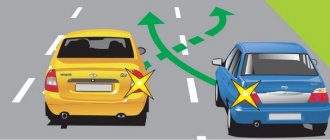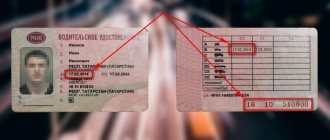What is the first step in drawing up a decision on a case or a protocol?
Despite the similarity of the documents, they are very different from each other. In particular, the difference in terms of compilation. To figure out which document is drawn up first, you need to familiarize yourself with what is hidden under the definitions.
Attention! If you have any questions, you can chat for free with a lawyer at the bottom of the screen or call Moscow; Saint Petersburg; Free call for all of Russia.
The traffic police protocol is a procedural document. Authorized officials are required to formalize it if there is an administrative offense and if any event occurs. The paper is drawn up if a traffic police inspector notices a violation of traffic rules in the actions of drivers. It must be borne in mind that drawing up a protocol does not yet confirm that the driver’s guilt has been proven.
In the process of drawing up a document, a traffic police officer may commit a gross violation. This will result in termination of further consideration of the case. The protocol acts as a starting point for the start of the proceedings. That is why it is issued first.
The traffic police decision is the result of consideration of the circumstances of the case. The specifics of its design directly depend on the seriousness of the incident. If the offense is minor, a verdict may be reached on the spot. If a gross violation of traffic rules is committed, a decision is made by the court. The paper is always drawn up after the fact of an offense has been documented.
The procedure for drawing up a protocol on an administrative offense
The protocol on an administrative offense must contain the following data (Article 28.2 of the Code of Administrative Offences):
2. The protocol on an administrative offense shall indicate the date and place of its preparation, the position, surname and initials of the person who compiled the protocol, information about the person against whom the case of an administrative offense has been initiated, surnames, first names, patronymics, addresses of the place of residence of witnesses and victims, if there are witnesses and victims, the place, time of commission and event of the administrative offense, an article of this Code or the law of a constituent entity of the Russian Federation providing for administrative liability for this administrative offense, an explanation of the individual or legal representative of the legal entity against whom the case was initiated, other information, necessary to resolve the case.
The protocol must indicate:
- Date and place of compilation.
- Traffic police officer details.
- Driver details.
- Data from witnesses and victims.
- Place and time of traffic violation.
- The event of an administrative offense and the article of the normative document providing for liability.
- Driver's explanation.
The text of the protocol is filled in by the traffic police officer (except for the “driver’s explanation” field). After drawing up the document, the driver should have the opportunity to familiarize himself with it:
4. An individual or a legal representative of a legal entity against whom a case of an administrative offense has been initiated must be given the opportunity to familiarize themselves with the protocol on the administrative offense. These persons have the right to submit explanations and comments on the contents of the protocol, which are attached to the protocol.
In addition, the driver can supplement the protocol with his own comments, which must be attached. Please note that if any fields or lines are left blank in the protocol, then put dashes in them. This will protect you from entering data into the document that is not in your favor.
After completing the protocol, it must be signed by the driver
and a traffic police officer.
Note. The driver must fill out the explanation field and then sign the protocol. For some reason, in practice, many drivers refuse to sign the document. I don't know what they are thinking about at this moment. However, the absence of even a basic explanation leads to the fact that the matter is not decided in their favor.
If the driver refuses to sign the protocol, a corresponding note is made in the document. This does not make the protocol invalid. There is simply no explanation or signature from the driver.
After drawing up the document, the driver receives a copy of it (Article 28.2 of the Administrative Code):
6. The individual or legal representative of the legal entity against whom a case of an administrative offense has been initiated, as well as the victim, is given a copy of the protocol on the administrative offense against signature.
Difference of concepts
The difference between a resolution and a traffic police protocol lies in the purpose of the papers and the legal consequences that their execution has for the driver. If the inspector has drawn up a protocol on the violation, there is no need to pay a fine. The driver's guilt has not yet been proven.
During the paperwork process, a person has the right to express his opinion. If he does not agree with certain factors, he can report this to the inspector who issued the paper. If serious errors were made when drawing up a traffic police report, it will be declared invalid. This will allow the driver to avoid liability for offenses committed.
The resolution is drawn up when the consideration of the case is completed. It sets out the punishment to which the offender is subjected. The driver has the right to appeal the decision in court. If this does not happen, the person is obliged to comply with the instructions contained in the paper.
Resolution or protocol on an administrative offense
If a minor offense has been committed, a verdict in the case may be reached on the spot. However, the driver has the right to demand that the inspector only document what happened by drawing up a report, and make a verdict in court.
Experts advise insisting on your own if there are controversial issues in the case. Proceedings in court will help you defend your case. A citizen cannot refuse to record a committed offense. The decision on the need for paperwork is made by the traffic police officer.
Deadline for issuing a decision
The protocol is the main evidence of the driver’s guilt. It is issued at the scene of the incident. There are exceptions to the rule. If there are controversial issues or details need to be clarified, the period for processing the document can be extended to two days. This is not considered a violation.
The resolution is drawn up after the proceedings on the administrative offense have been completed. If we are talking about a fine, the verdict is rendered within 2 months. In the case of a serious offence, the period may be extended to 3 months. If a decision is not made within this period, the case is closed.
The verdict in the case comes into force within 10 days from the date of its adoption. According to current legislation, the document is valid for 2 months. During this period, you must pay a fine to the traffic police. If a citizen has not complied with the order, enforcement proceedings may be initiated against him.
Purpose of documents and table of differences
A traffic police officer who has recorded the fact of non-compliance with traffic rules must necessarily draw up an administrative protocol directly at the scene of the incident.
This procedural document is not proof of the driver’s guilt; it only becomes the reason for starting paperwork and objectively assessing the actions of the accused citizen.
The resolution is issued after the investigation into the administrative offense. The paper clearly states the driver’s guilt, and also indicates the punishment for his actions.
All the differences can be found in the table:
| Protocol | Resolution |
| Issued at the scene of the incident | Compiled based on the results of an administrative investigation |
| Doesn't prove guilt | Confirms the fact of violation |
| No fines or other preventive measures are imposed on its basis. | Obliges the offender to pay a fine or suffer other punishment prescribed to him |
| Maximum preparation time – 2 days | Processing time – 2-3 months |
| Done in the presence of the accused | Published without the presence of the offender |
Both documents can be appealed in court.
When is a traffic police resolution drawn up without a protocol?
In practice, there are several cases in which a traffic police decision on a case can be issued without a protocol. This is possible in the following situations:
- The offense was recorded on photo or video cameras. Information about the need to pay a fine is sent by mail.
- If a citizen agrees with the violation that the traffic police inspector imposed on him.
- If an administrative penalty was imposed in the form of a warning or a fine at the scene of the offense. Only an authorized person has the right to perform such an action.
- The citizen does not dispute the existence of an offense.
A complete list of situations for drawing up a traffic police resolution without a protocol is enshrined in Article No. 28.6 of the Code of Administrative Offenses of the Russian Federation. A copy of the documented decision is provided against signature to the person in respect of whom it was made. If the person refuses to receive it, the paper is sent by mail. The action is carried out within 3 days from the date of the decision on the case.
When is the protocol drawn up?
In general, it is drawn up when a traffic police inspector has discovered a violation, but he cannot or is not authorized to make any decision on it. This is possible in the following cases:
- The driver does not agree with the violation and wants to challenge it. In this case, the protocol will serve as the main document in the trial;
- If the person who violated the rules is liable for military service;
- If the offender is a minor;
- If the traffic police inspector cannot make a decision on his own. For example, if the violation involves administrative arrest or deprivation of rights.
The traffic police protocol includes the following:
- Place of drawing up the protocol;
- Time for drawing up the protocol;
- Information about who filled out the protocol: full name and position;
- Information about the violator;
- Information about witnesses, witnesses, victims and other citizens involved in the incident;
- Description of the time, place and nature of the violation;
- Link to the article that has been violated;
- Testimony of witnesses and victims;
- Additional information that is somehow relevant to the case.
Sample protocol and sample resolution
In order for a protocol on an administrative offense to be recognized as valid, it must contain the information established by current legislation. The list of data that must be entered in the document is recorded in Federal Law No. 195. The list of mandatory information that must be present on the paper includes:
- date and place of registration;
- position and full name of the traffic police officer;
- information about the citizen who violated the established rules;
- date of commission of the offense and place of incident;
- norms and rights that require accountability for an action committed;
- other facts that will be useful during the proceedings.
The traffic police resolution must also comply with established standards. It reflects the following data:
- date and place of consideration of the case;
- information about the person who made the final verdict in the case;
- information about the citizen in respect of whom the document was issued;
- circumstances that were established as a result of the consideration of the case;
- reasoned decision on the proceedings;
- signatures of the participants in the proceedings.
The absence of mandatory information may result in the decision on violation of traffic rules being invalidated.
What must be included in the protocol on an administrative offense
Article 28.2 of the Code of Administrative Offenses describes in detail the main details of the protocol on an administrative offense:
- date and place of drawing up the protocol;
- position, surname and initials of the person who compiled the protocol;
- information about the person against whom a case of an administrative offense is being initiated;
- information about the person against whom a case of an administrative offense is being initiated;
- last names, first names, patronymics, addresses of witnesses and victims (all without exception); • place, time of commission and essence of the offense (the normative act that was violated by you);
- an article of the Code of Administrative Offenses or a law that provides for administrative liability for this offense;
- explanation of the individual or legal representative of the legal entity against whom the case was initiated;
- other information necessary for consideration of the case.
As you can see, the mandatory details of the protocol do not include the date and time of consideration of the case by the traffic police.
This is due to the fact that the specific time is determined at the stage of preparation for consideration of the case, and only inspectors in certain positions have the right to do this, and only for specific articles (positions and articles are listed in Part 2 of Article 23.3 of the Administrative Code).
Perhaps the position of the inspector drawing up the protocol is indicated in this list - then he has the right to combine the preparation of the protocol with preparation for consideration of the offense and immediately set the time for consideration. Otherwise, the traffic police authority will have to notify you of the date and duration of the review at a later date.
Rule of law
When preparing for the consideration of a case of an administrative offense, the following issues are resolved, on which, if necessary, a ruling is made:
1) on setting the time and place for consideration of the case;
2) on summoning the persons specified in Articles 25.1 - 25.10 of this Code, on requesting the necessary additional materials on the case, on ordering an examination.. (Part 1 of Article 29.4 of the Administrative Code)
Time between documents
The resolution is drawn up after the protocol. The period for taking action directly depends on the duration of the proceedings. Usually the effect takes place within 2-3 months. The exact period depends on the seriousness of the offense. So, if a citizen is issued a fine, it must be paid within 2 months.
If they want to confiscate a driver’s driving license or apply another, more severe punishment, the duration of the proceedings can be 3 months. If the final verdict has not been rendered, the proceedings are terminated. In this situation, a citizen can avoid punishment.
Protocol and resolution in one day
Cases when the traffic police protocol and resolution are drawn up on the same day are known in practice. This does not contradict current legislation. The approval is valid only if the decision is made by persons with appropriate authority in compliance with all existing procedural requirements.
However, such decisions can be appealed. A citizen has the right to appeal to a higher authority. The detailed rule is enshrined in Article No. 30.1 of the Code of Administrative Offenses of the Russian Federation. A complaint may be filed within 10 days. If an administrative investigation is required, the period is extended.
Deadline for drawing up a protocol on an administrative offense
The deadline for drawing up the protocol is regulated by Article 28.5 of the Code of Administrative Offenses:
1. A protocol on an administrative offense is drawn up immediately after the discovery of an administrative offense.
2. If additional clarification of the circumstances of the case or information about an individual or information about a legal entity is required in respect of which a case of an administrative offense is being initiated, a protocol on the administrative offense is drawn up within two days from the moment the administrative offense is discovered.
3. In the case of an administrative investigation, a protocol on an administrative offense is drawn up upon completion of the investigation within the time limits provided for in Article 28.7 of this Code.
In practice, when violating traffic rules, the first paragraph of the article is usually used, i.e. the protocol is drawn up immediately
. However, if necessary, the preparation may be delayed.
Resolution to cancel the protocol
The protocol drawn up by the traffic police officer may be cancelled. To carry out an action, the grounds enshrined in the Code of Administrative Offenses of the Russian Federation must be present. The court will agree to grant the request for cancellation in the following situations:
- required information is missing;
- during the preparation, violations of the norms of the Code of Administrative Offenses of the Russian Federation were committed;
- the official did not explain to the participants in the incident their rights and obligations;
- the statute of limitations for considering an administrative offense case has expired;
- other violations of the provisions of the current legislation were identified.
A resolution is drawn up to cancel. A similar rule is enshrined in paragraph 1 of Article No. 28.9 of the Code of Administrative Offenses of the Russian Federation.
What is a traffic police protocol
A traffic police report is a document that records the fact of an administrative offense.
It is important to know about the protocol:
- The transport police officer describes the event in the document, but does not impose a punishment, because it is not in his competence.
- A protocol can be drawn up in relation to a person over 16 years of age.
- The document must be filled out with a pen, not a pencil.
- It is allowed and recommended to film the filling process with a phone camera to avoid unlawful actions by police officers.
- After drawing up the document, you must read it carefully, make sure the information provided is true, and be sure to get a copy in your hands.
- If the offender does not agree with the charge against him and does not want to pay a fine (in cases provided for this by law).
The rules of procedure are approved in Art. 28.2 Code of Administrative Offenses of the Russian Federation.
What data does the protocol contain?
In our country there is no legislatively uniform form for a protocol on an administrative violation. Each state body approves it by internal order, but the contents of the document, as a rule, are the same.
The traffic police report on an administrative offense must indicate:
- date and place of occurrence of the illegal situation;
- personal data of the traffic police officer;
- information about the person (organization) who violated the law;
- if available: personal information about the injured party, witnesses;
- factual description of the violation committed, including eyewitness testimony;
- an indication of the regulatory document on which the police officer relies;
- explanation of the situation by the offender.
The violator must sign at the end of the page confirming receipt of his copy of the protocol.
How is the protocol drawn up?
The protocol is drawn up by a traffic police officer at the place where the administrative offense occurred, excluding cases requiring additional procedural measures.
The violator must receive an explanation of the text of the protocol, his rights and obligations, which he confirms with his signature. If you disagree with the accusation presented in the protocol, you must make an appropriate entry in it.
If the person in respect of whom the document is drawn up refuses to sign, the police officer notes this fact on the form.
Deadlines for completing the protocol
The process of preparing and signing the protocol takes place according to 3 scenarios, based on the specific situation:
- the picture of what happened is clear - the protocol is written on the spot;
- some nuances need clarification - the document can take up to 2 days to prepare (for example, if there are recordings from CCTV cameras);
- if an administrative official investigation is to be carried out - up to 1 month (for example, an examination is needed).
If the investigation of the parties to an administrative violation requires a longer period of time, then the period for drawing up a protocol can be extended to a maximum of 6 months with the written permission of the management of the authorities.
Errors and inaccuracies in the protocol
Paragraph 4 of the Resolution of the Plenum of the Supreme Court of the Russian Federation dated March 24, 2005 No. 5 states that judges should consider errors when checking the protocol:
- Significant errors are those that directly affect the consideration of the case. If there are such in the document, then the court can cancel its effect and close the proceedings:
- blank fields (if there is nothing to enter in a field, you need to cross it out with the “Z” symbol);
- absence of signatures of the offender and the traffic police officer;
- corrections in the document not endorsed by the signatures of the traffic police officer and the offender;
- the protocol was drawn up in the absence of the offender, and he was not informed about the place and time of drawing up.
- Minor errors are those that do not entail significant consequences for the court and can be leveled out in the process:
- spelling, punctuation, grammatical and other errors, except for inaccuracies in the full name;
- violation of the deadlines for drawing up the protocol without the grounds provided for by law;
- the absence of the offender during the preparation of the protocol for an unexcused reason.
If the judge identifies errors in the protocol, he must send the document for revision to eliminate them. But this can only be done at the stage of preparing the case before considering it on its merits.
Why do we need a protocol?
A protocol is drawn up in cases where it is necessary to send the case to court and apply a more serious punishment for a violation that poses a public danger.
But it is important to know that filling out the protocol is not proof of the offender’s guilt, but only the basis for initiating legal proceedings.
If the resolution does not specify a protocol
The list of information that must be present in the traffic police resolution is enshrined in article No. 29.10 of the Code of Administrative Offenses of the Russian Federation. According to the regulatory legal act, the document must necessarily reflect:
- information about the persons who made the decision in the case;
- place of consideration of the case and date of the procedure;
- information about the citizen against whom the punishment is applied;
- circumstances that were discovered during the consideration of the case
- a regulatory legal act that provides for liability for the offense committed;
- final verdict on the case;
- deadline and procedure for appealing a fine.
The set of additional information in the traffic police resolution depends on the individual nuances of the current situation. If the data is not required to reflect the resolution in accordance with Article No. 29.10 of the Code of Administrative Offenses of the Russian Federation, they do not need to be recorded in the document.
We issued a protocol and a resolution, what should we do?
If the driver violated the traffic rules, and this fact was documented in accordance with the established rules, you must carefully read the decision made. If you agree with the verdict, the person must pay the fine or comply with other instructions contained in the document.
If a person does not agree with the decision made, he can appeal the traffic police fine. To do this, you need to contact a higher judicial authority. You must appeal the decision with reasons. The citizen must provide evidence of his innocence. If they are absent, the likelihood of the punishment being canceled is minimal.
If a citizen plans to appeal the inspector’s decision, the established deadlines must be observed. You must contact a higher judicial authority within 10 days from the date of receipt of the document. If the deadline is missed without a valid reason, you will not be able to appeal the decision.
Having decided to comply with the order, the driver is obliged to comply with the established deadlines. The fine must be repaid within 2 months from the date the document enters into force. If the period is violated, bailiffs will be involved in the case. They will enforce the collection of the traffic police fine.
How to find a resolution according to the protocol?
Today it will not be possible to find information about the resolution if only the protocol is known. All existing online systems allow you to search for data only on the first document. However, a citizen will still be able to find out the information of interest. To do this, you need to use the traffic police service, which allows you to look for fines. To carry out the manipulation, you will need to perform the following steps:
- Visit the official website of the traffic police.
- Open the service, and then click on the item “check traffic police fines”. A window will open in front of the citizen that needs to be filled out. It is necessary to enter information about the car number and information about its registration. The data can be found by examining the vehicle's title.
- Click on the “request verification” button. If all actions are performed correctly, the system will display a table showing information about unpaid fines. One of the columns contains information about the resolution number.
Additionally, a citizen will be able to find out in accordance with what provision of the law he is being punished, as well as find out the amount of the penalty.









